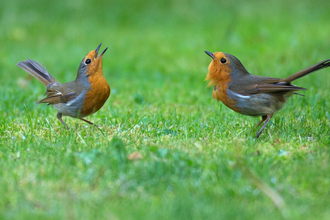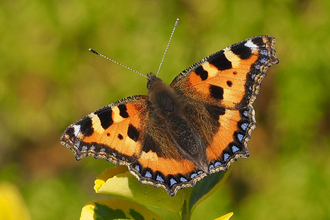My first sighting of a waxwing was in the most unlikely place to spot someone watching birds. It was a freezing cold November day and I'd heard rumours that a troop of waxwings were eating berries in trees on the edge of a supermarket car park alongside a main road into town. And there they were! We spotted them as we sat in the car at traffic lights, desperately hoping for the light to turn green so we could find a parking space before they flew off.
A waxwing winter?
Waxwings by Wendy Carter

Waxwing by Wendy Carter
They were well worth braving the weather for and I quickly understood why people get excited when they think a 'waxwing winter' is on its way. These beautiful birds, with peachy hues, striking black eye-stripes, a black bib and a punky crest, don't always arrive in the UK in big numbers. It looks like this winter may be the first in about a decade to have good numbers of waxwings filtering through the UK...providing a great opportunity to spot them right here in Worcestershire.
Waxwings are one of many species of bird that fly to and through the UK to escape harsher weather elsewhere. Unlike some, such as fieldfares and redwings, it's not guaranteed that any will arrive at all. Their irruption out of northern European countries depends on the availability of food. During summer they feed on insects but as the nights draw in and the temperatures drop, their diet switches to fruits. As they depart their forested breeding grounds in search of berry-laden trees, they join others doing the same. Before you know it, there can be hundreds-strong flocks roaming northern Europe and Scandinavia on the hunt for food. If they find plenty, they stay put. If they don't, they keep on moving; that's what can bring them to our shores.
This year, the first birds arrived on our coasts in autumn, just a trickle from late September into October along the east coast from the Shetlands to Northumberland. Then numbers began to build and sightings began to pour in from across the country. As I write, they're in our neighbouring counties and a few have hopped the border so I hope that more come and pay us a visit too.
Where to look
These are not birds of nature reserves or remote wild spaces but birds of urban supermarket car parks and streets. Wherever there are trees bursting with berries, keep a look out for waxwings. These might be rowans (one of their favourites), cotoneaster, viburnum or ornamental trees, full of yummy berries for the hungry birds to gobble down. Red berries appear to go first but are quickly followed by orange, yellow and even the white berries of mistletoe.
What to look for

Waxwing by Dave Grubb
Waxwings are a little smaller than a starling and, just like their spotty cousins, are usually seen in flocks. Their peachy face and under-tail colouring is complemented by warm greys and beiges. Their Amy Winehouse-like black eye-stripes and black bib combine with the perfectly coiffured crest, give them a punk-bordering-on-regal look as they rest in the branches between feeds. They have a bright yellow band across the end of the tail and yellow flashes on their wings. If you get chance to take a closer look, you'll see that some birds have glossy red tips to some of their wing feathers. It's these tips that give the birds their name; don't you think they look a little like the wax that was once used to seal letters? These tips develop as the birds age so younger ones in the flock may not have any yet.
Just occasionally you'll be lucky enough to hear their beautifully delicate trilling...




